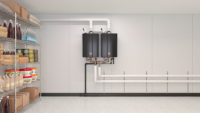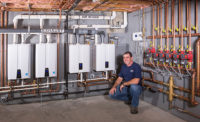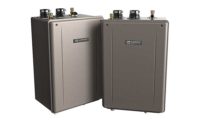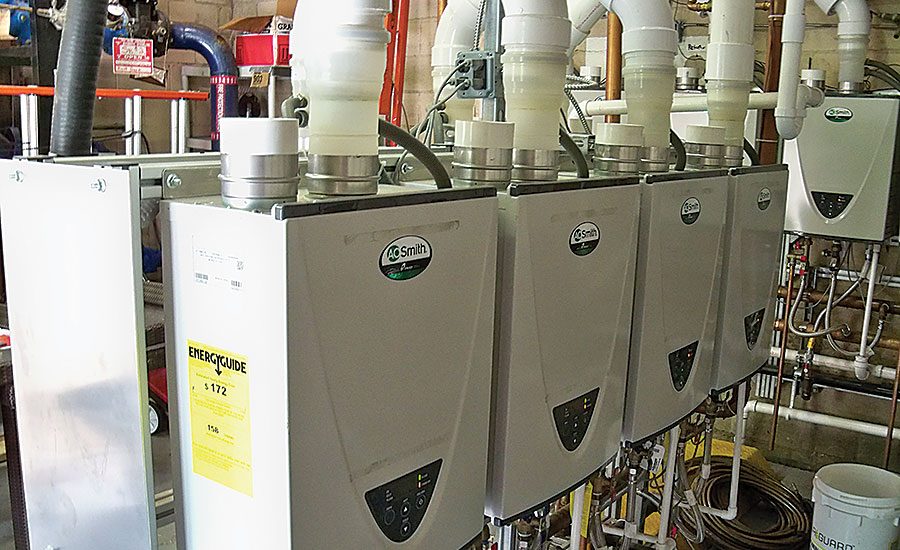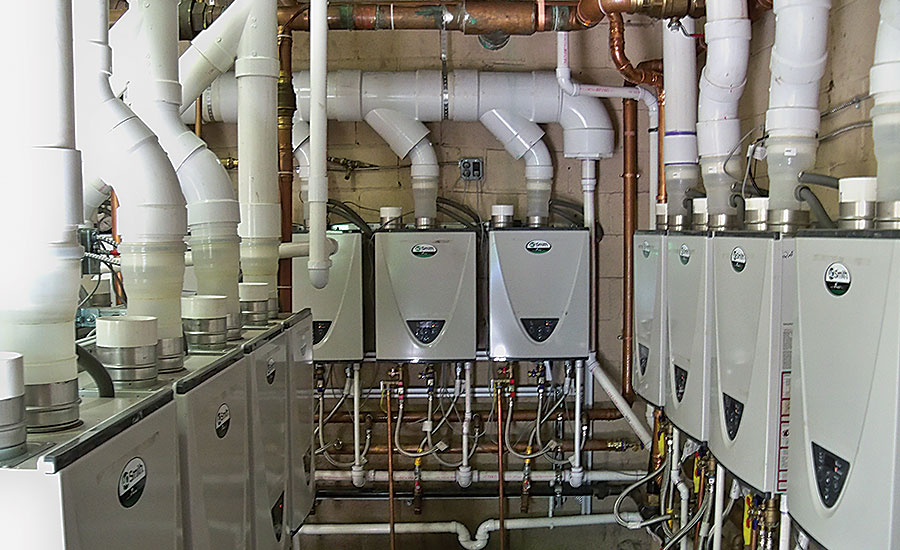Hotel installs tankless water heaters and reaps energy efficiency benefits
Making the switch.

The Holiday Inn Wilkes-Barre East Mountain installed 19 A. O. Smith condensing tankless water heaters as well as the manufacturer’s commercial tankless rack system and vent kit. The property manager says the new units have cut Btu output to heat water “in half, If not more.” Photo courtesy of A. O. Smith.

The Holiday Inn Wilkes-Barre East Mountain installed 19 A. O. Smith condensing tankless water heaters as well as the manufacturer’s commercial tankless rack system and vent kit. The property manager says the new units have cut Btu output to heat water “in half, If not more.” Photo courtesy of A. O. Smith.


When you’re in the hotel business, hot water is essential and running out is not an option.
For decades, twin 600-gal., commercial tanks provided hot water to the Holiday Inn Wilkes-Barre East Mountain in Wilkes-Barre, Pa. The primary unit and its backup delivered hot water to the hotel’s 154 guestrooms and facilities, which include a commercial laundry setup and two full-service kitchens.
According to Tom Wysokinski, owner of plumbing contractor All Service Rite, with a 2 million Btu burner in each unit, the twin-tank system managed hot water demand even during peak times, but the cost and labor associated with maintaining a 20-year-old system spurred the hotel to look for a new hot water solution.
Working with Ray Alles, regional property manager for The Manor Group, which owns and operates the hotel, the team outlined several goals for the project: performance (the hotel routinely sells out its room allotment) and providing ample hot water even in difficult high-demand situations (laundry and banquet facilities).
Additionally, the facility’s managers looked into options that would reduce energy consumption, free up space in the utility room and match other modern upgrades that were made to the hotel.
For starters, the All Service Rite team contacted Wilkes-Barre-based Eastern Penn Supply where inside sales specialist Rick Timchack Jr., worked with the contractor and manufacturers to develop the new hot water system.
“All Service Rite reached out and asked us to present some ideas,” Timchack Jr. says. “Like many projects today, a major factor in the decision was the facility’s desire for energy efficiency, so we provided multiple tankless options.”
The end result was the selection of A. O. Smith tankless units and its commercial tankless rack system and common vent kit.
Working with A. O. Smith and Eastern Penn Supply, the All Service Rite team developed a plan for a system powered by 19 A. O. Smith condensing tankless water heaters (each heater is capable of using up to 199,000 Btu/hr. of natural gas to deliver a maximum flow rate of 6.6 gpm and achieves an EF of 0.95).
The units were united via the A. O. Smith commercial tankless rack and common venting kit, a prefabricated and pre-plumbed system shipped ready for installation.
For the Holiday Inn project, Wysokinski recommended three commercial racks for the utility room with multiple configurations: one free-standing with six heaters, a second free-standing rack with seven heaters and a wall-mounted rack with six additional tankless heaters.
With a combined 3.8 million Btu of available power, both A. O. Smith and the All Service Rite teams felt confident the multi-link commercial rack system could manage any level of demand the hotel and its patrons could ask for.
After the racks were bolted in place and the heater assemblies were hung, the All Service Rite team connected the units to the gas pipe train, condensate train and created about 14 ft. of gas piping and water piping.
The commercial rack’s common venting option reduced the number of wall penetrations needed for intake and exhaust, allowing Wysokinski’s team to utilize three existing penetrations in the roof — one for each rack.
The team diverted the hot water system to the commercial rack and, one-by-one, heaters began to fire and deliver hot water throughout the hotel.
“Sensors tell the system how much flow is being demanded and the sequencer fires up the corresponding tankless heaters,” Wysokinski explains. “There were four busy weekends near full capacity and not a single problem was reported.”
One major advantage of the commercial rack system, according to Wysokinski, is redundancy. The units perform together but can be isolated at any time without interrupting hot water delivery. “With 19 tankless heaters, the system will never be without hot water even during maintenance,” he says.
After several months of successful operation, Alles says rack systems will definitely be considered for future applications. “The system has cut the Btu we’re using to heat water in half, if not more,” he states.
Wysokinski says he believes tankless technology gives commercial facility managers an attractive new option to consider for hot water delivery that, in some situations, he points out, reduces energy consumption as much as 40%.
“As managers see a return on their investment, we’re definitely getting more interest in tankless solutions,” he says.
This article was originally titled “Making the switch” in the November 2016 print edition of Supply House Times.
Looking for a reprint of this article?
From high-res PDFs to custom plaques, order your copy today!



